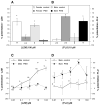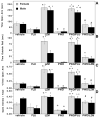Progesterone withdrawal increases the alpha4 subunit of the GABA(A) receptor in male rats in association with anxiety and altered pharmacology - a comparison with female rats
- PMID: 12367616
- PMCID: PMC2887344
- DOI: 10.1016/s0028-3908(02)00171-5
Progesterone withdrawal increases the alpha4 subunit of the GABA(A) receptor in male rats in association with anxiety and altered pharmacology - a comparison with female rats
Abstract
Withdrawal from the neurosteroid 3alpha,5alpha-allopregnanolone after chronic administration of progesterone increases anxiety in female rats and up-regulates the alpha4 subunit of the GABA(A) receptor (GABA(A)-R) in the hippocampus. We investigated if these phenomena would also occur in male rats. Progesterone withdrawal (PWD) induced higher alpha4 subunit expression in the hippocampus of both male and female rats, in association with increased anxiety (assessed in the elevated plus maze) comparable to effects previously reported. Because alpha4-containing GABA(A)-R are insensitive to the benzodiazepine (BDZ) lorazepam (LZM), and are positively modulated by flumazenil (FLU, a BDZ antagonist), we therefore tested the effects of these compounds following PWD. Using whole-cell patch clamp techniques, LZM-potentiation of GABA ((EC20))-gated current was markedly reduced in CA1 pyramidal cells of male rats undergoing PWD compared to controls, whereas FLU had no effect on GABA-gated current in control animals but increased it in PWD animals. Behaviorally, both male and female rats were significantly less sensitive to the anxiolytic effects of LZM. In contrast, FLU demonstrated significant anxiolytic effects following PWD. These data suggest that neurosteroid regulation of the alpha4 GABA(A)-R subunit may be a relevant mechanism underlying anxiety disorders, and that this phenomenon is not sex-specific.
Figures




Similar articles
-
Short-term exposure to a neuroactive steroid increases alpha4 GABA(A) receptor subunit levels in association with increased anxiety in the female rat.Brain Res. 2001 Aug 10;910(1-2):55-66. doi: 10.1016/s0006-8993(01)02565-3. Brain Res. 2001. PMID: 11489254 Free PMC article.
-
Progesterone withdrawal. II: insensitivity to the sedative effects of a benzodiazepine.Brain Res. 1998 Oct 5;807(1-2):91-100. doi: 10.1016/s0006-8993(98)00781-1. Brain Res. 1998. PMID: 9757006
-
Progesterone withdrawal reduces paired-pulse inhibition in rat hippocampus: dependence on GABA(A) receptor alpha4 subunit upregulation.J Neurophysiol. 2003 Jan;89(1):186-98. doi: 10.1152/jn.00195.2002. J Neurophysiol. 2003. PMID: 12522171 Free PMC article.
-
Neurosteroid regulation of GABA(A) receptors: Focus on the alpha4 and delta subunits.Pharmacol Ther. 2007 Oct;116(1):58-76. doi: 10.1016/j.pharmthera.2007.03.008. Epub 2007 Apr 21. Pharmacol Ther. 2007. PMID: 17512983 Free PMC article. Review.
-
The benzodiazepines: anxiolytic and withdrawal effects.Neuropeptides. 1991 Jul;19 Suppl:11-4. doi: 10.1016/0143-4179(91)90077-v. Neuropeptides. 1991. PMID: 1679209 Review.
Cited by
-
Progesterone reduces depression-like behavior in a murine model of Alzheimer's Disease.Age (Dordr). 2009 Jun;31(2):143-53. doi: 10.1007/s11357-009-9091-6. Epub 2009 Mar 26. Age (Dordr). 2009. PMID: 19322681 Free PMC article.
-
Neurosteroid enantiomers as potentially novel neurotherapeutics.Neurosci Biobehav Rev. 2023 Jun;149:105191. doi: 10.1016/j.neubiorev.2023.105191. Epub 2023 Apr 20. Neurosci Biobehav Rev. 2023. PMID: 37085023 Free PMC article. Review.
-
Catamenial epilepsy: the elusive condition.Epilepsy Curr. 2005 May-Jun;5(3):113-4. doi: 10.1111/j.1535-7511.2005.05301.x. Epilepsy Curr. 2005. PMID: 16145618 Free PMC article. No abstract available.
-
A forced swim-based rat model of premenstrual depression: effects of hormonal changes and drug intervention.Aging (Albany NY). 2020 Nov 21;12(23):24357-24370. doi: 10.18632/aging.202249. Epub 2020 Nov 21. Aging (Albany NY). 2020. PMID: 33229622 Free PMC article.
-
Ethanol Regulation of Synaptic GABAA α4 Receptors Is Prevented by Protein Kinase A Activation.J Pharmacol Exp Ther. 2016 Apr;357(1):10-6. doi: 10.1124/jpet.115.230417. Epub 2016 Feb 8. J Pharmacol Exp Ther. 2016. PMID: 26857960 Free PMC article.
References
-
- Akwa Y, Purdy R, Koob G, Britton K. The amygdala mediates the anxiolytic-like effect of the neurosteroid allopregnanolone in rat. Behavoral Brain Research. 1999;106:119–125. - PubMed
-
- Andrews N, File S, Fernandes C, Gonzalez L, Barnes N. Evidence that the median raphe nucleus--dorsal hippocampal pathway mediates diazepam withdrawal-induced anxiety. Psychopharmacology (Berlin) 1997;130:228–234. - PubMed
-
- Baldwin HA, File SE. Reversal of increased anxiety during benzodiazepine withdrawal: evidence for an anxiogenic endogenous ligand for the benzodiazepine receptor. Brain Research Bulletin. 1988;20:603–606. - PubMed
-
- Barbaccia M, Roscetti G, Trabucchi M, Mostallino M, Concas A, Purdy P, Biggio G. Time-dependent changes in rat brain neuroactive steroid concentrations and GABAA receptor function after acute stress. Neuroendocrinology. 1996;63:166–172. - PubMed
-
- Benke D, Michel C, Mohler H. GABA(A) receptors containing the alpha4-subunit: prevalence, distribution, pharmacology, and subunit architecture in situ. Journal of Neurochemistry. 1997;69:806–814. - PubMed
Publication types
MeSH terms
Substances
Grants and funding
LinkOut - more resources
Full Text Sources
Other Literature Sources
Medical
Miscellaneous

